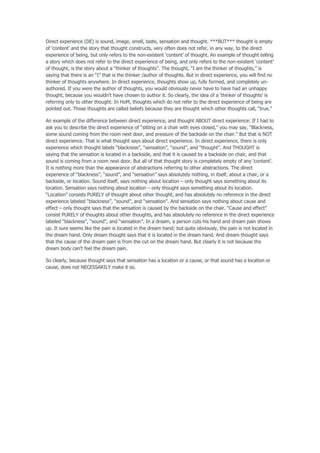Direct experience
- 1. Direct experience (DE) is sound, image, smell, taste, sensation and thought. ***BUT*** thought is empty of ¡®content¡¯ and the story that thought constructs, very often does not refer, in any way, to the direct experience of being, but only refers to the non-existent ¡®content¡¯ of thought. An example of thought telling a story which does not refer to the direct experience of being, and only refers to the non-existent ¡®content¡¯ of thought, is the story about a ¡°thinker of thoughts¡±. The thought, ¡°I am the thinker of thoughts,¡± is saying that there is an ¡°I¡± that is the thinker /author of thoughts. But in direct experience, you will find no thinker of thoughts anywhere. In direct experience, thoughts show up, fully formed, and completely un- authored. If you were the author of thoughts, you would obviously never have to have had an unhappy thought, because you wouldn¡¯t have chosen to author it. So clearly, the idea of a ¡®thinker of thoughts¡¯ is referring only to other thought. In HoM, thoughts which do not refer to the direct experience of being are pointed out. Those thoughts are called beliefs because they are thought which other thoughts call, ¡°true.¡± An example of the difference between direct experience, and thought ABOUT direct experience: If I had to ask you to describe the direct experience of ¡°sitting on a chair with eyes closed,¡± you may say, ¡°Blackness, some sound coming from the room next door, and pressure of the backside on the chair.¡± But that is NOT direct experience. That is what thought says about direct experience. In direct experience, there is only experience which thought labels ¡°blackness¡±, ¡°sensation¡±, ¡°sound¡±, and ¡°thought¡±. And THOUGHT is saying that the sensation is located in a backside, and that it is caused by a backside on chair, and that sound is coming from a room next door. But all of that thought story is completely empty of any ¡®content¡¯. It is nothing more than the appearance of abstractions referring to other abstractions. The direct experience of ¡°blackness¡±, ¡°sound¡±, and ¡°sensation¡± says absolutely nothing, in itself, about a chair, or a backside, or location. Sound itself, says nothing about location ¨C only thought says something about its location. Sensation says nothing about location ¨C only thought says something about its location. ¡°Location¡± consists PURELY of thought about other thought, and has absolutely no reference in the direct experience labeled ¡°blackness¡±, ¡°sound¡±, and ¡°sensation¡±. And sensation says nothing about cause and effect ¨C only thought says that the sensation is caused by the backside on the chair. ¡°Cause and effect¡± consist PURELY of thoughts about other thoughts, and has absolutely no reference in the direct experience labeled ¡°blackness¡±, ¡°sound¡±, and ¡°sensation¡±. In a dream, a person cuts his hand and dream pain shows up. It sure seems like the pain is located in the dream hand; but quite obviously, the pain is not located in the dream hand. Only dream thought says that it is located in the dream hand. And dream thought says that the cause of the dream pain is from the cut on the dream hand. But clearly it is not because the dream body can¡¯t feel the dream pain. So clearly, because thought says that sensation has a location or a cause, or that sound has a location or cause, does not NECESSARILY make it so.

